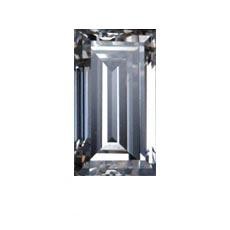The Baguette Cut is a distinct rectangular diamond shape, typically with step-cut faceting, although it can also be found in square form. It is most often used as accent stones in jewellery but can also be used as the centerpiece in certain designs, particularly in vintage or Art Deco styles.
Characteristics of Baguette Cut Diamond
Shape:
The Baguette cut is known for its rectangular shape with straight edges. It can also be found in a square version, known as a “square Baguette”.
The shape is typically very symmetrical, with cut corners or sharp edges, giving it a clean, elegant appearance.
Faceting Style:
The Baguette cut features step-cut faceting, meaning the facets are straight and parallel to each other, descending from the table to the culet. This cut is different from the brilliant cut, which has more facets and is designed for maximum sparkle.
The step-cut faceting of the Baguette cut gives the diamond a subtle sparkle, as the light reflects off the facets in a hall-of-mirrors effect. However, it doesn’t exhibit the intense brilliance seen in diamonds with brilliant cuts.
Size and Proportions:
Baguette diamonds are typically long and rectangular in shape, although the square Baguette is also a popular option.
The proportions of the Baguette are important; a well-proportioned Baguette cut diamond will appear symmetrical and aesthetically pleasing.
Brilliance and Sparkle:
Baguette diamonds have less sparkle than other diamond shapes like round brilliant or princess cuts due to the step-cut design. The absence of many facets results in a more subdued sparkle, making Baguette diamonds a good choice for those who prefer elegance over extreme brilliance.
The clarity of a Baguette cut diamond is more noticeable due to its larger, flat facets. Any inclusions or flaws are more visible than in diamonds with more facets, making clarity an important consideration when selecting a Baguette cut diamond.
Colour:
Since Baguette diamonds have fewer facets, the colour of the diamond can be more noticeable. As such, it’s generally advisable to choose a higher colour grade, such as H or better, to avoid visible yellowish tones.
Clarity:
The clarity of a Baguette diamond is especially important because the large, flat facets can reveal imperfections. Flawless to VS1 clarity diamonds are generally preferred for this cut.
Uses of the Baguette Cut Diamond
Accent Stones:
Baguette diamonds are often used as side stones or accents in jewellery, particularly in engagement rings and wedding bands. Their elegant, linear shape complements other diamonds, especially round brilliant or princess cuts, by adding a touch of sophistication and vintage flair.
In a three-stone ring, Baguette diamonds are sometimes used on either side of a larger central diamond.
Vintage and Art Deco Styles:
The Baguette cut is a popular choice in vintage, retro, and Art Deco-style jewellery due to its clean lines and symmetry. The cut’s sophisticated simplicity complements the bold geometric patterns of these design eras.
Standalone Centrepiece:
While not as common as other diamond shapes for a central diamond, Baguette diamonds can be used as a unique, elegant centerpiece for engagement rings or pendants. They are often set in a way that emphasizes their clean, linear beauty.
Advantages of the Baguette Cut
Elegant Simplicity:
The Baguette cut has a simple and clean aesthetic, which makes it ideal for those who appreciate understated elegance. It has a timeless, classic appeal that never goes out of style.
Perfect for Side Stones:
Baguette diamonds are widely used as accent stones because they can be paired easily with other shapes, such as round or princess cuts, to create a striking contrast. Their long, narrow form provides a beautiful frame to a larger diamond.
Cost-Effective:
Baguette diamonds tend to be more affordable than other cuts of the same carat weight because the faceting process requires less precision, and the diamonds typically have less sparkle. As a result, they can offer good value compared to other shapes like round brilliant or princess cuts.
Unique Appeal:
The Baguette cut’s classic and vintage feel makes it a great choice for those who want something a bit different from the typical modern diamond cuts. It offers a chic, sophisticated look for people who enjoy minimalist designs.
Considerations When Buying a Baguette Cut Diamond
Clarity:
Since Baguette diamonds have larger, flat facets, inclusions are more visible than in other cuts with smaller facets. It’s important to choose a diamond with a high clarity grade, such as VS1 or higher, to avoid visible flaws.
Proportions and Symmetry:
As with any diamond, the proportions and symmetry of a Baguette cut diamond are important for achieving the desired aesthetic. The diamond should have a well-balanced shape with symmetrical facets to ensure it reflects light evenly.
Light Reflection:
While the Baguette cut has a more subdued sparkle compared to other cuts, it still has a unique reflective quality due to its step-cut faceting. When buying a Baguette diamond, it’s essential to look for one that reflects light well, with clean, well-defined facets.
Size and Carat Weight:
Baguette diamonds are typically smaller than other shapes like round or princess cuts, so buyers may choose to purchase multiple Baguette diamonds to create a more significant visual impact in a ring or setting.
Baguette Cut vs. Other Diamond Cuts
Round Brilliant Cut: The round brilliant cut is the most popular diamond shape due to its maximum sparkle and brilliance. The Baguette cut, on the other hand, offers a more subdued, sophisticated appearance with a focus on clarity and elegance.
Emerald Cut: The emerald cut also uses step-cut faceting, like the Baguette cut, but it is typically larger and has more defined corners. Emerald cut diamonds also feature a larger surface area, making the inclusions more visible, much like the Baguette.
Princess Cut: The princess cut is another square-shaped diamond, but unlike the Baguette, it is a brilliant-cut diamond, giving it more sparkle. Baguette diamonds are rectangular and are more subtle in their brilliance.
